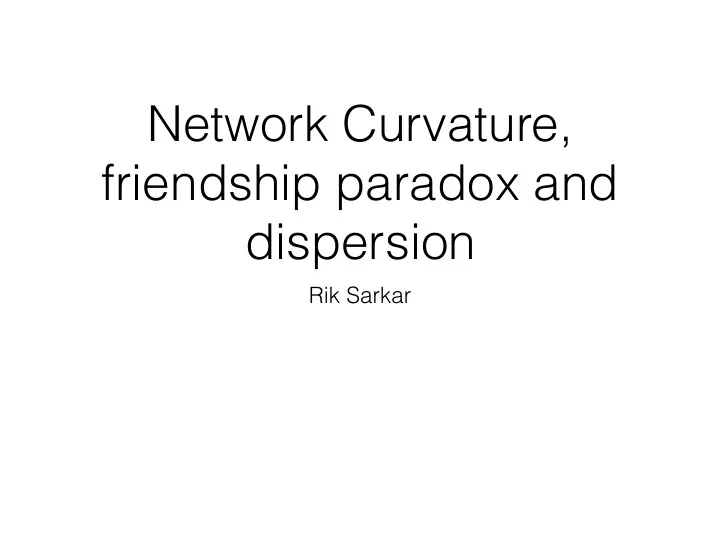

Network Curvature, friendship paradox and dispersion Rik Sarkar
Recap: Hyperbolic distances • Points in a disk • Shortest paths along circular curves bent toward the center • Similar to internet paths being bent toward the core • Distances look cramped close to the boundaries
Internet emulates hyperbolic metrics • Shavitt, Tankel. ACM ToN 2008.
Hyperbolic model for networks • People connect to popular “central” nodes • Preferential attachment. Hubs. Cause small diameters. • People connect to other “similar” nodes • Similar in location, or interests, or communities • Similar means small distance in some measure • Preferential attachment does not model this well • Cannot model the clustering properties
Popularity/similarity model • Put all nodes on the plane at polar coord: (r, θ ) • Popularity: Distance from the center • Like preferential attachment, earlier nodes are popular • If a node appears at time t, its distance from center is r = ln t • Interests/features for similarity: Represented by angle • θ • Two nodes a,b are similar if | θ a - θ b | is small.
Edge attachments • A new node appears at time t • Sets r = ln t • Sets θ = random • It connects to the k nearest nodes in hyperbolic distance • Central nodes are older and higher degree
Properties • Creates power law distribution • Creates strong clustering • Different from pref. attachment • More realistic in real networks
Modeling the internet • A suitable hyperbolic embedding gives very good model of connection probabilities • Similar results in other power law networks
Actor networks • Does not work equally well
• Popularity vs Similarity in Growing Networks • Papdopoulos et al. Nature 2012.
Hyperbolic geometry • Useful in modeling metrics with exponential growth (number of nodes within distance x) • E.g. balanced binary tree • Many parameters may have such properties • Position in a hierarchy • Topological types of paths in a domain • Subsets of items
Few other things
Friendship paradox • Your friends have more friends than you do! • Are you less social than others?
Friendship paradox • The paradox: • If you ask everyone to report their degrees, you get the average degree • If you ask everyone to report the average degrees of their friends and take the averages of all, • you get more than the overall average degree! • Most of us have some popular friends (hence they are popular) • If you pick a random friend of a random person, (random edge) • This friend is relatively likely to be popular, since popular nodes have more edges
Friendship paradox • Average degree of nodes: • A node with degree d(v) contributes d(v) once • Average degree of a friend: • Each person picks a friend and counts degree • A node with degree d(v) contributes d(v) times, with total contribution d(v) 2 • A few nodes with relatively high d(v) can skew the count • https://en.wikipedia.org/wiki/Friendship_paradox • S. L. Feld, Why your friends have more friends than you do, American journal of sociology, 1991
Identify spouses or romantic partners • Suppose you have the facebook graph • Only the graph and nothing else • Can you identify which edges correspond to spouses or romantic partners?
Identify spouses or romantic partners
Identify spouses or romantic partners • Tie strengths are important • Romantic ties tend to be of high strength, more likely to transmit information • Do you expect romantic links to have high embeddedness (number/fraction of common friends)?
• People have clusters of friend circles • Work, school, college, hobbies • Edges in these have high embeddedness, even if they are not strong friends
• Spouses usually know some friends in each-others different circles • The edge does not have high embeddedness • Compared to links in groups such as school/ college • But, it has a dispersed structure: • There are several mutual friends, but the mutual friends are not well connected among themselves
Dispersion • dispersion between u,v • Notations: • C(u,v): Common friends of u, v • G u : Subgraph induced by u and all neighbors of u • d uv : distance measured in G u -{u,v}: Without using u or v X disp ( u, v ) = d uv ( s, t ) s,t ∈ C ( u,v )
Dispersion X disp ( u, v ) = d uv ( s, t ) s,t ∈ C ( u,v ) • Increases with more mutual friends • Increases when these friends are far in the graph • It is possible to use other distance measures • Good results with d = 1 if no direct edge, 0 otherwise
Normalized dispersion • Use norm(u,v) = disp(u,v)/embed(u,v) • 48% accuracy • Apply recursively, to weigh higher nodes with high dispersion • Gives 50.5% accuracy • 60% accuracy for married couples • High accuracy considering hundreds of friends • Works better than usual machine learning based on posts, visits, photos etc features • Best results with combination of features
• Backstrom and Kleinberg. Romantic partnerships and dispersion of social ties, ACM CSCW 2014
Recommend
More recommend